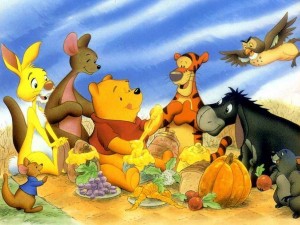In 1926 A.A. Milne wrote the first collection of stories about a bear called Winnie the Pooh and his friends. The ‘Pooh Bear’ stories became globally known when Disney adopted them and adapted them for a series of very successful features. A.A. Milne’s original stories have been translated into a multitude of different languages and the merchandise is sold every day all over the world.
Everybody knows about Pooh and his friends, everyone has read the books or watched the movies and seen the images. What is extraordinary about the characters found in these stories, is that each one of them represents the personality types found on the Enneagram. I have no idea whether or not A.A. Milne knew the Enneagram (I have not read anywhere that he did), but as far as I know, he was certainly was no expert on the Enneagram even if he did know about it. This only goes to indicate to me that each type on the Enneagram is so easily recognizable because the explanations of the Enneagram types are so very accurate.
But what it also provides for us, nearly 100 hundred years after the stories were written, is a keen insight into the key characteristics of each Enneagram type. Because we all know the Pooh stories and therefore know what their characteristics are, perhaps we can use them to help us remember what the characteristics of each of the personality types are, so that we can understand and empathize with ourselves and our colleagues better.
- The rabbit: the one
- Kanga (Roo’s mother): the two
- Gopher: the three
- Eeyore: the four
- Owl: the five
- Piglet: the six
- Tigger: the seven
- Gorilla: the eight
- Winnie the Pooh: the nine
If you know the characters in the story, can you identify with any of them? So, for example, if you are a five, you may be able to look at the owl and think to yourself, that could be me! You may think of someone you work closely with and think that they really are rather like Pooh, they might be a nine.
Obviously it would be better to read about the Enneagram either by Googling it, or by purchasing one of the excellent books written on the subject. The best thing to do is to go on an Enneagram Course, which TomorrowToday offers. In a connection economy, where the focus or differentiator for successful people is their ability to connect with people (or build sustainable and productive relationships with people) the Enneagram provides the best map that I know of to develop oneself as well as a clear understanding of others. There is often a lot of tolerance expressed for others, but I wonder how much empathy genuinely exists within workplaces. In order to build authentic relationships, I think empathy is an imperative.
If haven’t read or seen it already, engage with the most famous bear and his friends; and see if that pricks your interest in one of the most useful business tools around.



